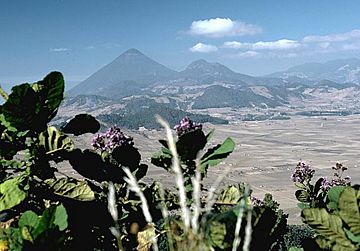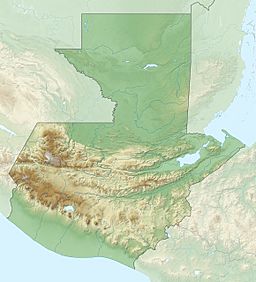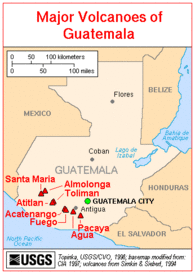Almolonga facts for kids
Quick facts for kids Almolonga volcano |
|
|---|---|
| (Cerro Quemado) | |

The rounded hills in the middle, are part of a chain of lava domes of the Almolonga volcanic field
|
|
| Highest point | |
| Elevation | 3,197 m (10,489 ft) |
| Geography | |
| Location | Quetzaltenango, Guatemala |
| Parent range | Sierra Madre |
| Geology | |
| Mountain type | Stratovolcano |
| Last eruption | January to June 1818 |
The Almolonga volcano is a cool mountain in Guatemala. People also call it "Cerro Quemado," which means "Burned Mountain." Another nickname is "La Muela," or "The Molar," because of its unique shape.
This volcano is a type called a stratovolcano. It is found in the southwest part of Quetzaltenango. The volcano sits close to the town of Almolonga. It is also just south of Quetzaltenango, which is Guatemala's second biggest city.
Contents
What is Almolonga Volcano?
Almolonga volcano is part of a special area where the Earth's plates meet. This area is called the Zunil fault zone. The volcano has a large bowl-shaped hollow at its center. This hollow is known as a caldera.
Around the caldera, you can see several lava domes. These are like big, rounded hills made from thick, sticky lava. The volcano started forming about 84,000 years ago.
How the Volcano Changed Over Time
Almolonga volcano is the oldest part of this volcanic area. Long ago, the top of the volcano collapsed. This created the big caldera, which is about 3.3 kilometers wide. It is also about 350 meters deep.
Later, new lava domes grew inside the caldera. Volcanic ash and rocks from other volcanoes also covered the area.
Cerro Quemado: A Key Part
Cerro Quemado is the largest and youngest part of Almolonga. It is a complex of eight lava domes. These domes formed from very thick lava. This happened during four different periods of volcanic activity.
About 1,150 years ago, a part of Cerro Quemado collapsed. This caused a huge landslide. The landslide traveled about 6 kilometers. It covered an area of 13 square kilometers. This event also created a powerful blast. The blast even affected a nearby volcano called Volcán Siete Orejas. After this, a new lava dome grew in the collapsed area.
Last Eruption and Future Risks
The last time Almolonga volcano erupted was in 1818. From January to June of that year, it produced a slow-moving lava flow. This lava flow traveled about 2.5 kilometers to the east.
Volcanoes like Almolonga can still be dangerous. Future risks include lahars, which are mudflows mixed with volcanic debris. There is also a risk of more explosive eruptions. Scientists keep a close eye on these volcanoes to help keep people safe.
See also
 In Spanish: Volcán de Cerro Quemado para niños
In Spanish: Volcán de Cerro Quemado para niños
- List of volcanoes in Guatemala



